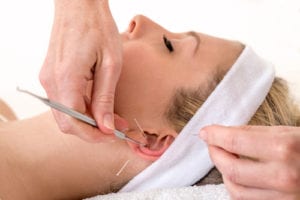 Acupuncture has long been regarded as an effective method for treating musculoskeletal dysfunction. A mainstay in Chinese medicine since the ancient world, acupuncture is now practiced regularly in the West. Auriculotherapy is a localized form of acupuncture which is performed on the ear, rather than the entire body. At Doyle Chiropractic, Dr. Cody B. Doyle offers both acupuncture and auriculotherapy to treat dysfunction within the musculoskeletal system and help his patients enjoy enhanced overall wellbeing.
Acupuncture has long been regarded as an effective method for treating musculoskeletal dysfunction. A mainstay in Chinese medicine since the ancient world, acupuncture is now practiced regularly in the West. Auriculotherapy is a localized form of acupuncture which is performed on the ear, rather than the entire body. At Doyle Chiropractic, Dr. Cody B. Doyle offers both acupuncture and auriculotherapy to treat dysfunction within the musculoskeletal system and help his patients enjoy enhanced overall wellbeing.
The Difference between Acupuncture and Auriculotherapy
Acupuncture and auriculotherapy are similar in many ways. They both involve stimulating certain points on the body via the insertion of ultra-thin needles. Both practices help to reopen energy channels that have been blocked by pathology. In fact, auriculotherapy is a practice within the field acupuncture. As aforementioned, the primary difference is that auriculotherapy is exclusively performed on the external ear. Why is this? According to the ancient philosophy of Taoism, there are 12 different energy channels – six Ying meridians and six Yang meridians. In traditional acupuncture, the six Yang meridians directly coincide with the external ear. There are several reflex points located on the external ear which are connected to the central nervous system. Simply stated, auriculotherapy is acupuncture that treats the entire body, but is only practiced on the ear.
How Does Auriculotherapy Work?
To expand on the notion that the external ear is directly connected to larger regions of the body, imagine the anatomy of the human auricle (the outer portion of the ear). When you examine it closely, it looks like an inverted fetus. This is called somatotopic inversion, meaning the ear is a map of the entire body. Therefore, stimulating the earlobe would treat eye conditions, while stimulating the top of the ear would treat issues with the heels, ankles, and toes.
Why are Acupuncture and Auriculotherapy Performed in Chiropractic Care?
With acupuncture and auriculotherapy, literally every tissue type and system within the body is at your fingertips. Around the small outer edge of your ear lies the key to every musculoskeletal system in the body! Therefore, it is quite common to use auriculotherapy in conjunction with chiropractic care. This practice can alleviate muscle spasms in the back, ease spinal manipulations, and more. In fact, it can be utilized any time there is a desire to enhance chiropractic procedures. Acupuncture and auriculotherapy are both used in other healthcare fields as well, whenever appropriate.
Is Acupuncture Widely Accepted as “Real” Medicine?
Although acupuncture and auriculotherapy have been considered mainstream in Chinese medicine for centuries, the Western world has been slow to catch up. However, it is important to note that the majority of healthcare professionals in the West now affirm the benefits of such treatment. Currently in the United States, many doctors accept acupuncture and auriculotherapy as complementary medicine. This not only means it is a valid form of alternative medicine, it also means it can be used in conjunction with conventional medical treatments. Best of all, these treatments are effective for patients of all ages with little to no side effects.
Learn More about Acupuncture and Auriculotherapy
If you are interested in learning more about treatments in complementary medicine, schedule a consultation at our Roanoke, TX chiropractic office today. Dr. Doyle can help you determine if acupuncture or auriculotherapy is right for you. Call us at (817) 767-5430 or contact us online anytime.
**Dr. Doyle received his training to perform acupuncture at Texas Chiropractic College. He performs acupuncture to improve dysfunction within the musculoskeletal system of the body, in accordance with the scope of practice of a chiropractor in the State of Texas. While placing needles in the certain point’s in the musculoskeletal system can have numerous non-musculoskeletal systemic benefits, Dr. Doyle does not directly treat any condition that does not have at it’s core a musculoskeletal component. Instead, he treats only those dysfunctional points within the musculoskeletal system that he identifies after a thorough history and examination. If treating a musculoskeletal acupuncture point produces a non-musculoskeletal benefit, that benefit is purely incidental. **